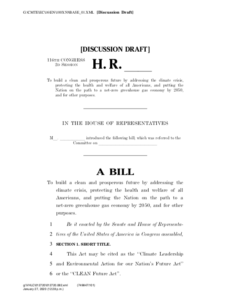US House draft bill defines ammonia as low-carbon fuel
By Trevor Brown on February 13, 2020

In January 2020, the US House of Representatives published draft legislation that explicitly defines ammonia as a “low-carbon fuel.” This is a first. The CLEAN Future Act is focused on electricity generation, and aims “to build a clean and prosperous future by addressing the climate crisis, protecting the health and welfare of all Americans, and putting the Nation on the path to a net-zero greenhouse gas economy by 2050.”
The point isn’t that this will become law — that seems unlikely anytime soon — but that a mature understanding of the potential benefits of ammonia energy has finally reached policymakers in the heart of Washington DC.
In its various definitions of “low-carbon” fuels, the CLEAN Futures Act states the following:
(14) QUALIFIED LOW-CARBON FUEL.—
(A) IN GENERAL.—
The term ‘‘qualified low-carbon fuel’’ means a fuel that—
(i) is produced through any process that significantly limits or avoids greenhouse gas emissions; and
(ii) does not release any greenhouse gas during combustion.(B) INCLUSION.—
US House of Representatives, CLEAN Future Act discussion draft, January 27, 2020
The term ‘‘qualified low-carbon fuel’’ includes, subject to subparagraph (A)—
(i) ammonia; and
(ii) hydrogen.
In the sixteen years since the founding of the Ammonia Energy Association in 2004 (originally the Ammonia Fuels Network, later the NH3 Fuel Association), there has been minimal acknowledgement of the roles ammonia could play in a low-carbon economy at the federal level, and certainly nothing approaching legislation. The CLEAN Future Act represents a marked departure, therefore, and an opportunity for ammonia energy proponents.
This draft bill is not law and is unlikely to become law, at least not in its existing form. A recent article in The Hill described the context for this bill in the current political scene:
“We’re treating this climate crisis like the emergency that it is,” House Energy and Commerce Chair Frank Pallone (D-N.J.) said of the so-called CLEAN Future Act … “I don’t want you to see this as a messaging bill. We’re going to try to move this bill or pieces of this bill when we can.”
Republican leaders on the committee expressed an interest in working with Democrats on some portions of the bill, hoping that some aspects of the legislation will align with a package of a dozen pieces of legislation that tackle climate change through technological innovation, greater reliance on natural gas and nuclear, and developing better battery storage.
Energy and Commerce Ranking Member Greg Walden (R-Ore.) said he hoped some of those pieces of bipartisan legislation could be a starting point for tackling climate issues.
“My view is always if we can get that done, let’s get that done. And then we can argue about other stuff where we may come to terms, and there will be things where we’re just polar opposites, right? But we ought to grab the things that are already bipartisan, and move forward on those.”
The Hill, Democrats outline sweeping legislation to make U.S. carbon neutral by 2050, January 8, 2020
Last month, I wrote an article that described how, moving beyond R&D departments, Ammonia energy is now a talking point for CEOs. Again, the conversation has progressed, and we can now demonstrate that ammonia energy is a talking point for Washington DC policymakers too.